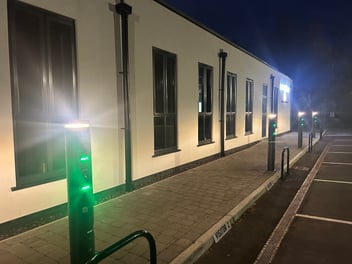
Bridging the Gap: Accelerating EV Charging Station Rollout in Rural UK
Not got time to read? Listen instead with our audio version
The transition to electric vehicles (EVs) represents a crucial step toward a greener future, but for many rural communities in the UK, this future feels frustratingly out of reach. While urban areas are seeing rapid growth in charging infrastructure, rural regions face unique challenges that are slowing down EV adoption. Let's explore the current state of rural charging networks and the innovative solutions being developed to bridge this growing urban-rural divide.
The Rural Charging Challenge
The numbers tell a striking story: only 15% of public chargepoints in England are located in rural areas, with approximately one charging point every ten miles – a stark contrast to London's one chargepoint every 0.75 miles. This disparity isn't just about numbers; it's about access to essential infrastructure that enables sustainable transportation choices.
For rural residents, this limited infrastructure creates a classic chicken-and-egg problem. Without reliable charging options, potential EV buyers hesitate to make the switch. Yet without growing EV adoption, private companies see little incentive to invest in rural charging networks. This has led to what many call "charging deserts," where the lack of infrastructure effectively locks communities out of the EV revolution.
Why Are Rural Areas Falling Behind?
Several factors contribute to the slower rollout of charging infrastructure in rural regions:
- Economic Challenges: Lower population density makes it less financially attractive for private companies to invest in charging infrastructure
- Geographic Spread: Rural areas cover larger territories, making it more expensive to create comprehensive charging networks
- Infrastructure Limitations: Many rural areas face challenges with electrical grid capacity and connectivity
- Lower Initial Adoption: With only 2% of vehicles in county areas being plug-in electric vehicles, there's less immediate demand driving infrastructure development
Government Support: Bridging the Infrastructure Gap
Recognising these challenges, the UK government has launched several initiatives to support rural charging infrastructure:
- A £7 million Rural Connectivity Fund to improve remote area charging access
- The Local Electric Vehicle Infrastructure (LEVI) Scheme, provides £2.2 million for rural charging infrastructure
- A £950 million Rapid Charging Fund supporting the rollout of high-powered charge points across England's motorways and major A-roads
These programs aim to ensure that rural communities aren't left behind in the transition to electric mobility. However, success will require more than just government funding.
Innovative Solutions Taking Shape
Exciting developments are emerging to address rural charging challenges:
- Community-Led Initiatives: Rural communities are taking charge by developing local charging solutions through collective investment and partnerships
- Smart Grid Integration: Advanced technology is helping manage power distribution more efficiently, particularly crucial in areas with older electrical infrastructure
- Business Partnerships: Local businesses are stepping up by installing charging points, creating convenient access while supporting their communities
- Off-Grid Solutions: Innovative battery and solar-powered charging options are being explored for areas where traditional infrastructure is challenging
The Path Forward
Creating a comprehensive rural charging network requires a collaborative approach. Private companies can contribute by:
- Developing new business models that make rural charging stations economically viable
- Forming strategic partnerships with local businesses and communities
- Leveraging government incentives to offset installation costs
- Investing in innovative technologies that reduce infrastructure requirements
As we move toward the government's target of 300,000 charge points by 2030, ensuring equitable distribution between urban and rural areas is crucial. Rural communities shouldn't have to choose between embracing sustainable transportation and maintaining their way of life.
Looking Ahead
The expansion of rural EV charging infrastructure represents more than just technical progress – it's about ensuring equal access to sustainable transportation options for all UK residents. While challenges remain, the combination of government support, private sector innovation, and community engagement offers hope for a more connected and sustainable future.
Through continued collaboration and investment in innovative solutions, we can bridge the urban-rural charging divide and make electric vehicle adoption a realistic choice for everyone, regardless of where they live.
Ready to Support Rural EV Infrastructure?
At Ratio EV, we understand the unique challenges of rural charging infrastructure. Our io7 and io8 charging pillars are specifically designed to meet these challenges head-on, offering:
- Built-in Professional Lighting: Essential for safe charging in rural areas with limited street lighting
- Flexible Payment Options: Including contactless, mobile app, and RFID solutions that work even in areas with limited connectivity
- Smart Load Management: Our io7 and io8 Sense systems efficiently manage power distribution, crucial for rural locations with varied grid capabilities
- Durable Design: Built with high-grade materials to withstand diverse weather conditions and require minimal maintenance
- Future-Proof Technology: Over-the-air updates ensure your charging infrastructure stays current without requiring regular site visits
Whether you're a local authority, business owner, or charging infrastructure provider looking to expand into rural areas, Ratio EV's charging solutions are designed to deliver reliable, sustainable charging options for every community. Contact us today to learn how we can help you bridge the rural charging gap.
Related Articles

A Future-Ready EV Charging Solution
As more and more drivers join the electric vehicle (EV) revolution, Ratio EV’s io7 chargers are...
Read more
Future proof: How Ratio EV’s io8 is Enabling Efficient, Expandable, EV Charging
When ThermoFisher Scientific began exploring EV charging options, they faced several challenges.
...
Read more
Lighting Up Electric Vehicle Charging with Staycold Export and io7
Ratio EV’s io7 pillars have lit up electric vehicle (EV) charging at one of the UK’s leading...
Read more
